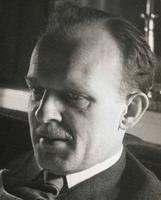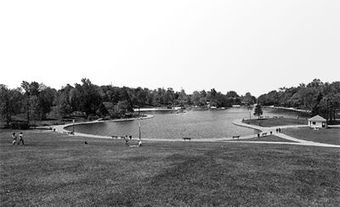
H.P. Daniel van Ginkel
H.P. Daniel van Ginkel, "Sandy," architect, planner, sculptor (b at Amsterdam, Netherlands 10 Feb 1920, d at Toronto 6 July 2009). A tireless innovator and projector, Sandy van Ginkel was one of the first architects in Canada to have applied the principles of modern design and planning to the urban environment in all its forms. In this respect he played a key role in the modernization of Canadian architecture, civic design and transportation planning.Van Ginkel studied architecture at Elkerlyc Academy of Architecture and Applied Art, Lage Vuurse, Netherlands, and sociology at the University of Utrecht. He then worked in architecture and planning offices in the Netherlands, Sweden and Ireland and had his own architectural practice in Amsterdam. This experience brought him into contact with a wide range of European modernists including J. Bakema, Cornelius van Eesteren, Sven Markelius, Aldo van Eyck and Ralph Erskine. Van Ginkel himself was aligned first with Congrès Internationaux de l'Architecture Moderne (CIAM) and then Team X, for whom he drafted the Doorn Manifesto.
In 1957 van Ginkel moved to Montréal with his Canadian wife Blanche Lemco VAN GINKEL and established van Ginkel Associates, a multidisciplinary design and management firm. Their timing was propitious as Montréal - and Canada - was on the verge of rapid development, and Canadian planning and urban design in its infancy. Among the earliest projects of the firm were the planning of Bowring Park in St John's and a series of critical Montréal studies that led to the protection of the historic centre (particularly Old Montréal) in the face of inevitable development. They included the Montréal Port Study (1958-59), the Central Area Circulation Plan (1960-61), a plan for Old Montréal (1960-61), and planning and design for EXPO 67 (1962-67).
Subsequent work influenced the course of development across North America and Asia. This includes the design of a prototype airport terminal facility for Transport Canada (1970); an atlas of the communities of the Mackenzie (1975); a study on building in the North for Canadian Arctic Gas (1976) and the completion of a development plan for Pahang Tenggara, Malaysia (1973). Particularly notable was Movement in Midtown (1970-71), a circulation plan for Midtown Manhattan and the development of a new urban transit vehicle, dubbed the Ginkelvan (1973).
Sandy van Ginkel published widely in both professional and popular journals, and lectured in various capacities to university students of architecture, planning and urban design. In 1986 he was the Thomas Jefferson Professor of Architecture at the University of Virginia. In 1991 van Ginkel designed an exhibition of the work of John C. Parkin at Academy House, Toronto. From 1989 on, he worked primarily as a sculptor. In 2003 he was awarded the Order of Urbanists of Quebec for his contribution to urbanism and to protecting the heritage of Montréal. In 2007 he was named a member of the ORDER OF CANADA.

 Share on Facebook
Share on Facebook Share on X
Share on X Share by Email
Share by Email Share on Google Classroom
Share on Google Classroom


